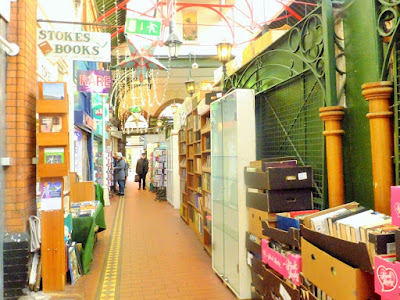 |
| The Temple Bar area of Dublin is popular with tourists, but watch out: The bars raise their Guinness prices as the night wears on. |
 |
| Posing on the Ha'Penny Bridge, Ken is happy how great our surprise extra day in Dublin has turned out. |
Our flight from Bordeaux to Dublin is uneventful, and both our room and our Airbnb host are very nice. We arrive too late in the day to take the bus into downtown Dublin, so we grab a bite at a convenient but uninspiring American-style diner.
The next morning, we arrive back at the airport and are told that our flight to San Francisco has been over-sold and we have been bumped. At first, I am indignant and a bit rude to the bearer of bad news: an Aer Lingus customer service representative (and saint) named Chloe. But as it turns out, I couldn't have ended up more satisfied.
The next morning, we arrive back at the airport and are told that our flight to San Francisco has been over-sold and we have been bumped. At first, I am indignant and a bit rude to the bearer of bad news: an Aer Lingus customer service representative (and saint) named Chloe. But as it turns out, I couldn't have ended up more satisfied.
 |
| Molly Malone, of 'Cockles and Mussels' fame is a popular statue in Dublin. For some odd reason, it's apparently acceptable to grope her. The song is the city's unofficial anthem. |
 |
| I strongly suspect that these blokes are brothers, busking in Dublin. |
Aer Lingus puts us up in a nearby hotel, which we arrive at just in time for a traditional Irish Sunday roast dinner. The receptionist asks what time we would like dinner that evening and reminds us that the next morning's breakfast is also included. The food is delicious, and oh, did I mention that Aer Lingus also paid us 600 euros each for our inconvenience? (This is the law, but it's still a delightful consolation prize as it nearly covers the cost of our airline tickets).
 |
| We are urged to go to O'Neill's in Dublin for good food and music, but we aren't able to stay up late enough. Maybe on our next visit. |
 |
| The old and the new provide an interesting contrast in Dublin. |
We also get to spend a lovely sunny afternoon in Dublin (we're told it's the first day without rain in many weeks). And finally, arriving one day late in San Francisco means that we missed the wild fires that had caused traffic havoc the day before.
 |
| Ken stands beside Christ Church Cathedral, Dublin's oldest working structure. |
I am sharing pictures here that were taken on that beautiful afternoon, along with some that were taken six weeks later when we passed through Dublin on our return. On that day, we take a pleasant free walking tour of the city, which helps to fill in the gaps on the sites we had seen on our earlier visit. And when we arrive at the airport the next morning for our flight to Bordeaux, I am able to find and thank Chloe for her patience and professionalism.
 |
| Saint Patrick watches over the portal of Dublin Castle's Chapel Royal. |
 |
| Trinity College Dublin is home to this bronze sculpture by Arnaldo Pomodoro, called 'Sphere Within Sphere' ('Sfera con sfera'). |
If our train from Bordeaux to Marmande hadn't been been cancelled because of les grèves, I would have been able to declare our three-day voyage home practically perfect. Thank goodness for good friends like Paul who drives to the airport to pick us up. Cheers, or as they say in Ireland, mianta!
 |
| We duck inside this galleria in Dublin for a coffee and a quick browse. |
 |
| Dublin's main shopping street is decorated for the holidays. |











































